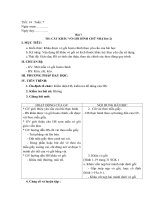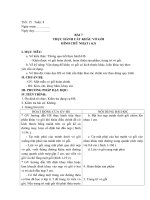Bài 7. Nitơ
Bạn đang xem bản rút gọn của tài liệu. Xem và tải ngay bản đầy đủ của tài liệu tại đây (1.28 MB, 31 trang )
Chapter 8
Table of Contents
1. Introduction
2. Occurrence
3. Chemical properties
4. Compounds
5. Uses
Nitrogen family
1. Nitrogen family. Introduction
Chapter 8
Placement in the periodic table
Click
Click to
to edit
edit Master
Master text
text styles
styles
Second
Second level
level
Third
Third level
level
Fourth
Fourth level
level
Fifth
Fifth level
level
Chapter 8
1. Nitrogen family. Introduction
Placement in the periodic table, continued
Nitrogen
Phosphorus
Arsenic
Antimony
Bismuth
14
7N
31
75
15P
33As
122
51Sb
209
83Bi
Chapter 8
1. Nitrogen family. Introduction
Placement in the periodic table, continued
Common oxidation numbers are - 3,+1,+2,+4 and +5.
Metallic character increases from top to bottom.
N and P are nonmetals, As and Sb are metalloid, Bi is a metal.
All have allotropes, except N and Bi.
Phosphorus has white, red and black allotropes.
Nitrogen is very important for living organisms, exist in construction of proteins and nucleic acids.
Chapter 8
1. Nitrogen. Introduction
Placement in the periodic table, continued
Isotopes:
14
15
7N and 7N
Earth`s crust abundance: 0.002 %
2 2 3
Electron configuration: 1s 2s 2p
0
Melting point: -210.1 C
0
Boiling point: -195.8 C
Density: 0.00125 g/l
Common oxidation number: -3,-2,-1,0,+1,+2,+3,+4,+5
Physical state: gas
Colour: colourless
Discovery date: 1772
Discoverer: Daniel Rutherford
Discovery place: Scotland
Chapter 8
1. Nitrogen . Introduction
Placement in the periodic table, continued
Has two names. One "azot", meaning "dead" in Latin, was given by Lavoisier, other, "nitrogen",
means "nitrate former".
Little soluble and lighter than air.
Isotopes have 99.64% of
Forms diatomic structure (N2) and inactive element
14
15
N and 0.36% of N
Chapter 8
2. Nitrogen . Occurrence.
Occurrence.
Percentage of N2 gas in the atmosphere is 78% by volume and 75% by mass
Found in compounds in the earth's crust at a rate of only 0.002% by mass
Mineral sources of nitrogen are
Potassium nitrate (Saltpeter) – KNO3
Sodium nitrate (Chile saltpeter) – NaNO3.
Chapter 8
2. Nitrogen . Occurrence.
Occurrence.
Nitrogen
Nitrogenisisaa basic
basicelement
elementin
in living
living organisms
organismsas
aswell
wellas
asititisisused
usedin
inthe
the production
productionof
of DNA
DNA and
and
fertilizers.
fertilizers.ItItisisfound
foundin
inliving
livingorganisms
organismsas
asbuilding
buildingstone
stonein
innucleic
nucleicacids,
acids,in
inproteins
proteinsand
andvitamins
vitaminsby
by
15%.
15%.
2. Nitrogen . Occurrence.
Chapter 8
Preparation.
Preparation in laboratory:
1.
1.Heating
Heating the
the mixture
mixture of
ofNaNO
NaNO22and
andsaturated
saturatedNH
NH44Cl
Clgives
givespure
pureNN22gas.
gas.
NaNO
NaNO22(aq)
(aq)++NH
NH44Cl(aq)
Cl(aq)→
→NaCl(aq)
NaCl(aq)++2H
2H22O(l)
O(l)++NN22(g)
(g)
2.
2.CO
CO22must
mustbe
beremoved
removedfrom
fromthe
the air
airsample
sample by
bypassing
passing ititthrough
through aaconcentrated
concentratedbase
basesolution.
solution.
2NaOH(aq)
2NaOH(aq)++CO
CO22(g)
(g)→
→ Na
Na22CO
CO33(aq)
(aq)++HH22O(g)
O(g)
The
The air
airisisthen
thenreacted
reacted with
with hot
hotcopper
copperpowder.
powder.Oxygen
Oxygenin
inair
airisisfiltered
filteredby
byforming
formingcopper
copper(II)
(II)oxide.
oxide.
2Cu(s)
2Cu(s)++(3N
(3N22++O
O22)) →
→ 2CuO(s)
2CuO(s)++2N
2N22(g)
(g)
2. Nitrogen . Occurrence.
Chapter 8
Preparation.
Preparation in laboratory:
3.
3.Decomposition
Decomposition of
of sodium
sodiumazide,
azide,NaN
NaN33or
orbarium
barium azide,
azide,Ba(N
Ba(N33))22
2NaN
2NaN33(s)
(s)→
→2Na(s)
2Na(s) ++3N
3N22(g)
(g)
This
Thisreaction
reaction isisapplied
appliedin
in the
the air-bag
air-bagof
of automobiles.
automobiles.
Chapter 8
2. Nitrogen . Occurrence.
Preparation.
Preparation in industry:
The
Themain
mainsource
sourceof
of NN22isisthe
theair
airand
andititisisobtained
obtained by
byfractional
fractionaldistillation
distillation of
of liquified
liquifiedair
airin
inindustry.
industry.
Nitrogen
Nitrogenevaporates
evaporatesfirst
firstduring
duringthe
thedistillation.
distillation.
Because
Becausethe
theboiling
boilingpoint
pointof
of oxygen
oxygen isis-183°C
-183°Cand
andthe
theboiling
boilingpoint
pointof
of nitrogen
nitrogenisis-196°C
-196°C
Chapter 8
2. Nitrogen . Occurrence.
Chapter 8
2. Nitrogen . Occurrence.
Chapter 8
2. Nitrogen . Occurrence.
Chapter 8
3. Nitrogen . Chemical prop.
Nitrogen
Nitrogen may
maytake
takeall
alloxidation
oxidation numbers
numbersbetween
between-3
-3and
and+5.(:N
+5.(:N N:)
N:)Bond
Bondbetween
betweenNNatoms
atomsisisvery
very
strong
strongthat
thatisiswhy
whyNN22does
doesnot
notreact
reactwith
withacids,
acids,bases,
bases,water
waterand
andhalogens.
halogens.
1. At high temperatures, it reacts with active metals.
6Na + N2 → 2Na3N
0
2. At 300 atm. pressure and 500 C temperature , nitrogen gas react with H 2 .(Haber method).
N2 + 3H2 → 2NH3
0
3. At 2500 C or in high electrical current (lightning).
N2 + O2 → 2NO
4. Nitrogen . Compounds.
Chapter 8
a) Ammonia – NH3
Colorless gas
Sharp smell
Lower density than air
0
Boiling point is -33.4 C
0
Freezing point is -77.8 C
Very high solubility in water
Weak base
Preparation in Industry: Prepared by Haber Process
N2 + 3H2 → 2NH3
Preparation in Laboratory:
NH4Cl + NaOH → NaCl + H2O + NH3
Chapter 8
4. Nitrogen . Compounds.
a) Ammonia – NH3
Haber, Fritz (1868-1935), German chemist and Nobel
laureate, best known for his development of an
economical method of ammonia synthesis.
Chapter 8
4. Nitrogen . Compounds.
a) Ammonia – NH3
Reactions of Ammonia
1.
React with acids and give salts.
NH3+ HCl → NH4Cl
2.
Forms ammonium hydroxide in water.
NH3 + H2O → NH4OH
3.
React with pure oxygen.
4NH3 + 3O2 → 2N2+ 6H2O
4.
Good reducing agent.
2NH3+ 3CuO → 2Cu+ N2+3H2O
Chapter 8
4. Nitrogen . Compounds.
Chapter 8
4. Nitrogen . Compounds.
Chapter 8
4. Nitrogen . Compounds.
0
A colorless liquid with 5.2 g/ml of density. Melting point is -42 C and the boiling point is
0
82.6 C. When metallic nitrate heated with concentrated sulfuric acid .
NaNO3(s) + H2SO4(aq)
NaHSO4(aq) + HNO3(aq)
Nitric acid is the third most important industrial acid (after sulfuric and phosphoric
acid). It is used to prepare fertilizers, explosives, nylon and plastics.
Nitric Acid (HNO3)
Nitric acid is commercially produced by the
Ostwald process.
4NH3 + 5O2
2NO + O2
3NO2 + H2O
4NO + 6H2O
Pt
2NO2
2HNO3 + NO
Production of Nitric Acid
Nitric Acid (HNO3)
Lightning may cause to form nitric
acid.
Do you afraid
May be
acid rain
of
rain
Lightning may cause to form nitric
acid.









